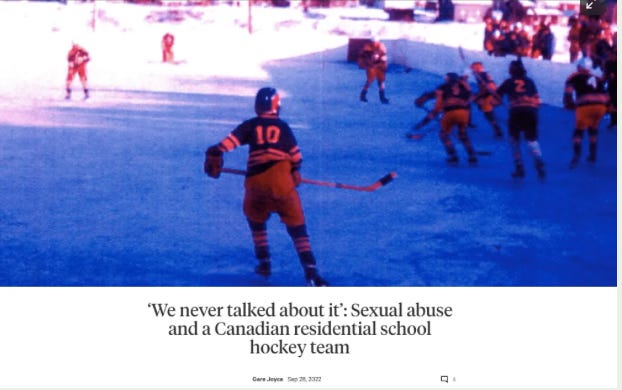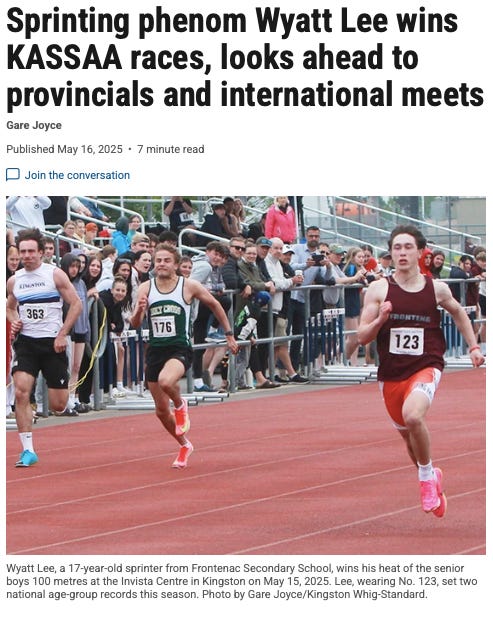No. 283: WYATT LEE, MICHAEL FARBER, DOUG HAPPYJACK et al / The only piece of meaningful advice that I'd offer young sportswriters is unfathomable to most old-school scribes.
It boils down to two words: "Stay interested." Doesn't mean that your work will be a success, but at least it will keep you keeping on.
THIS goes back to December of ’21, the height of COVID and the wind-down of my run at Sportsnet. On what was just about my last assignment with the outfit, I was driving eight hours north of Ottawa to Waswanipi, to do a story on a team of kids rounded up from across Cree territory. The peg was the team’s hopes of making it to the Quebec peewee tournament and a bit of the backstory was that famous tourney’s regrettable history related to the teams of indigenous kids from residential schools. All of this is to say that I had a lot of story to work with.
Then in the course of reporting the story in Waswanipi I met the brother of the chief, Doug Happyjack, who had been among the last kids to attend a Quebec residential school and played in the big peewee tournament for a team coached by an Anglican priest who sexually abused Doug and his friends.1 For the story behind these stories check out this very early entry from the SubStack: No. 17: THE CREE NATION (EEYOU) / Behind the scenes on my stories from Waswanipi. (I’ve removed the paywall on this one.)
On the last leg of the northbound drive, I rolled cautiously through a blizzard and near white-out conditions. I went up a two-lane highway where, over a three-hour period, I saw only one other vehicle on the road, a logging truck straddling the centre line going 130k straight at me, and I passed nary a gas station or, in fact, any sign of civilization. If I hit a moose or went off the road I might not have been found until spring.
I used the drive to make a few phone calls for as long as the signal would last. This wasn’t purely social, mind you—I thought I was laying the breadcrumbs in case my rental broke down or ran head-on into the next logging truck. I called up another scribe, a guy a few years younger than me who was retired—I don’t know to what degree that was voluntary on his part, but less than he advertised. When I told him where I was and what I was doing, he registered disbelief.
“You still want to do that stuff?” he asked.
This from a guy who never wanted to anything like this stuff.
“I was the one who pitched the idea,” I said.
I offered this up to his bafflement. My friend got into the sportswriting biz, covering the NHL and big events, to avoid workplace inconveniences far less bothersome than this white-knuckled drive through a snowstorm with daylight fading. He got too old for this stuff when he had a full head of hair.
This extreme example of what I’m willing to do for a story, the tug that good material has on me, came to mind the other day when Michael Farber, he of the Montreal Gazette, Sports Illustrated and TSN, sent me a foreword he wrote for my sportswriting memoir which will be published in the fall of 2026, not posthumously if I can help it.
(Working title: A Portrait of the Artist as a Young Hockey Scribe. Pretentious? Idiotic? Hey, I earned the right to appropriate any intellectual property given I’ve spent six-plus decades fielding questions about James Joyce. “Any relation?” the smart-asses will ask, not that any of them have read a word of his work. For the record, James Joyce’s grandfather was from just down the road from the farm that my father grew up on in Galway, the farm that my cousin and his family still operate. Never really pursued a deep dive on my bloodlines. Everyone in those parts were and are Joyces.)
This first edition of A Portrait of the Artist as a Young Man listed as fine is available at Whitmore’s Rare Books for $3,850 US. A Portrait of the Artist as a Young Hockey Scribe will be much more affordable next fall and to my mind a lot more fun.
Asking Michael Farber to write a foreword is akin to asking Jerry Lee Lewis to open for you—it’s tough to follow a piano bench in splinters and a Steinway set on fire. I’ll have 300 pages to try in vain to match anything that Michael put together in 800 or 1,000 words. It seemed like a good idea at the time.
I won’t reprint Michael’s foreword here, simply because it will make everything else I do in this space look bad. I will seize on one line because it landed with me. Leave it to Mr F to come up with a bit of insight into what I do and who I am that never occurred to me.
“Joyce is the most interesting Canadian sportswriter because he is the most interested. His curiosity is boundless. If Wayne Gretzky peered around corners, Joyce saw through thickets of nonsense to find a good story. When he had to use a machete, well … that was even more satisfying.”
Okay, I can do without the superlatives, but I’ll take Michael’s point about my curiosity—not that I consider it flattery, just a clear read of my motivations. There are a lot of ways to land a bigger buck and gain more fame and the vast majority rely on you remaining incurious. “Going with the flow” captures it nicely, so does “going along to get along.”
Yet I still get a buzz, a tingling of my spider senses, when I happen on a good story with intrigue and emotional stakes. Doesn’t need to be a big name. Doesn’t need to be in the spotlight. And, yeah, sometimes the smaller stuff that might be missed is even more satisfying. That feeling, that draw, has never gone away. I hope it never will.
Look, I’m sliding down the Batpole to age 70 and some sportswriters would consider working a local high-school track meet in Kingston as a shitty assignment. Wait, I wrote “some sportswriters” … who am I kidding? No one I’ve met in the business would look forward to going to an event at that level. Except me.
This wasn’t a matter of personal taste, though that a longstanding interest in track factors into it. I ran the 800 in high school, won a Toronto district as a junior, set a school record, ran on a winning relay team at the provincial indoor championships. (See: No. 144: PETER SNELL / The greatest athlete I ever talked to, a three-time Olympic gold medalist, took refuge in his anonymity.)
Yeah, I peaked in Grade 12, but so what? I can look at a sheet of numbers, times, distances, heights, what-have-you, and pick up points of interest that others would certainly miss.
Still, the other day, when the teens from local high schools congregated, I was there with bells on and carrying a Canon with an 80-to-200. Yeah, at this very late stage of my career I’m now a two-way guy, words and photos. I lug a camera everywhere now.
In this case, I knew precisely who’d be the focus of my attention: a 17-year-old named Wyatt Lee who didn’t own a pair of spikes when he came out for the Kingston Secondary track team 13 months before, who had no idea how to set up his blocks last spring but finished second in the provincials in the 100, who just a couple of weeks ago set a new Canadian age-group record, one that had been set by Aaron Browne, a member of the 4 X 100 relay team that won gold at the Olympics in Paris last year.
Here’s the story that came out of it:
The writing’s not my best, I’ll admit—I was working with a tighter turn-around than I would have been if I were writing for a mag and that turn-around was made all the tighter by juggling photo and captioning and display in the mix. The point here isn’t the art, though. No, I was genuinely interested in Wyatt’s story—I don’t know what his future might hold and neither does he, but there’ll definitely be something. He was all wide-eyed and sorta stunned by going from neophyte to a kid on the radar for international competition—he didn’t know how to set up his blocks and in less than a year he’s faster in high school than Donovan Bailey was.
I wanted to say to Wyatt that I’ve been in a few dances like this with a teenager whose future was so shiny. I wanted to tell him that I talked to Sidney Crosby before he played a game in the Q and Connor McDavid before he could get go for his driver’s license. I’ve talked to all kinds of young and gifted folks and not just in sports. That interests me still. Maybe there’s a vicarious aspect to it—check that, there’s a vicarious aspect to it, an investment. Still, I get a charge out of telling stories like Wyatt Lee’s, being first on the scene. And I still get a charge out of telling stories like Doug Happyjack’s, important stories that would otherwise have gone untold and remained buried.
I’m still interested.
Originally intended for Sportsnet, the story about Doug Happyjack wound up becoming a feature in The Athletic. Them’s the breaks and them’s the fruits of being interested.







There's no way to overstate the significance of having Mike Farber write the forward to your upcoming book. I was lucky enough to have Jack Nicklaus (or more likely Jack's assistant, a former newspaper colleague of mine named Scott Tolley) write mine. In my estimation Mike is to hockey writing almost what Jack was to golf. When the Panthers came to a city he happened to be in we would get together for lunch on game days; he had a keen interest in Mike Keenan and I happened to have covered him as both coach and GM. And when we were covering Stanley Cup Finals together he was responsible for what I still consider a great honor: getting an invite to dinner with the Canadian scribes. Brilliant but humble - the rarest of combinations.